Online Facilitation
The next step in our framework begins the facilitation unit. We will discuss facilitation strategies. The unit learning outcome is: I can facilitate my blended course. The mastery challenges are now facilitation challenges. As always, formative evaluation will be conducted to help you thoroughly think through your facilitation decisions.

Learning Outcome
I can explain how instructor facilitation influences student learning.
Sub-section outcomes:
I can distinguish between online facilitation and design. (Section 9.1)
I can articulate how online course design affects an instructor’s ability to facilitate learning. (Section 9.2)
I can explain why developing online facilitation skills is important. (Section 9.3)
I can categorize interactions as learner-learner, learner-instructor, and learner-content interactions. (Section 9.4)
I can describe each of Berge’s four categories of facilitation: pedagogical, social, managerial, and technical. (Section 9.5)
I can discuss how cognitive, social, and teaching presence interact to create a community of inquiry. (Section 9.6)
I can describe the affective, behavioral, and cognitive dimensions of engagement. (Section 9.7)
I can compare and contrast different frameworks for talking about online learning facilitation. (Section 9.8)
9.0 Introduction
By definition, to facilitate something is to make it easier. In the context of a discussion, a facilitator would help the discussion run more smoothly and effectively. Similarly, in the context of blended and online courses, the goal of facilitating is to help your learners have a smoother experience when learning the content, participating in activities, and interacting with others. All of which should, hopefully, have a positive effect on learner engagement and learning outcomes.
Many blended and online courses are facilitated by one person—the course instructor. This instructor may be the same person who designed and created the course, or it could be another faculty member or adjunct instructor who was tasked with teaching the course. And while some instructors may be facilitating on their own, others may have teaching assistants or other support. Instructors may also teach learners to be effective facilitators in online discussions and teamwork. In any of these scenarios, the instructor is the main facilitator of the course.
Facilitating a course typically involves a variety of roles, such as guiding learners through the learning process, clarifying instructions, helping learners utilize technology, and promoting discussions and interactions with and between learners.
The course facilitator may have a variety of responsibilities within these roles, such as:
Creating a course navigation video
Guiding discussions
Making regular announcements
Answering learners’ questions
Clarifying assignment instructions
Supporting group interactions
Establishing and enforcing course policies
Giving personalized feedback on learner assignments
Encouraging and acknowledging learner contributions
See Figure 9-1 for some verbs describing what facilitators do.
Figure 9-1
What Facilitators Do
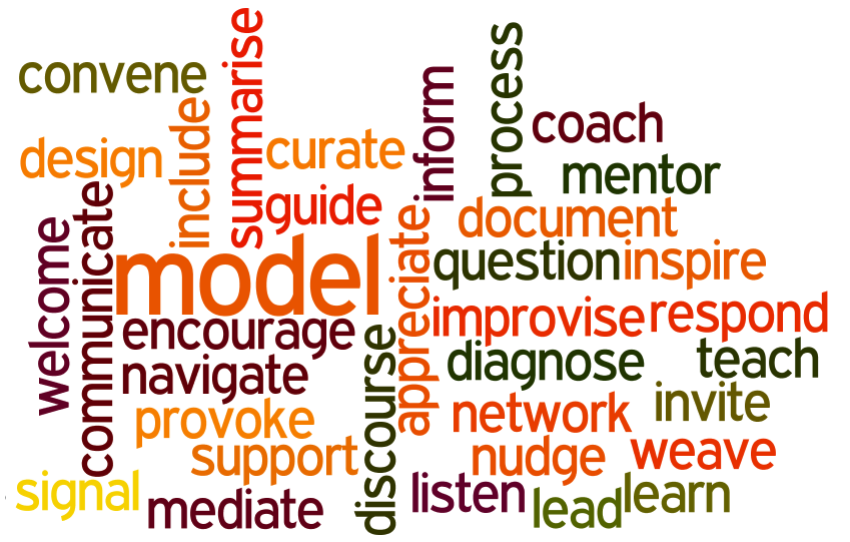
What Online Facilitators Do by Tony Carr, CC-BY-4.0
We need to begin with the Facilitation Competency Self-Assessment. Since this is a pre-test, you might expect to score between 0 and 10, especially if you have little or no previous experience.
Facilitation Competency Self-Assessment
Points | Competency Level |
|---|---|
0 | No Design Competency |
1-5 | Novice Level |
6-10 | Intermediate Level |
11-15 | Advanced Level |
16-19 | Superior Level |
20 | Expert Level |
9.1 Facilitation vs. Design
Learning Outcome: I can distinguish between online facilitation and design.
In Chapter 1, we related the design of a course to the design of a building. The blueprint of a course, like the blueprint of a building, shows how each of the elements will work together, with each element designed for a particular purpose. After a course has been designed, facilitation is like a building being used for the purposes it was designed for. Now that the course (or “building”) has been developed, how are you going to help your learners use what has been created to maximize their learning?
Consider an asynchronous discussion. The course designer was careful when designing the prompt: choosing words that would enable evaluative and divergent thinking and setting guidelines on the structure, content, flow and timing of responses (see Chapter 5).
Now envision two instructors simultaneously teaching this course as described in Table 9-1.
Table 9-1
Two contrasting examples of facilitating online discussion
Facilitator 1 | Facilitator 2 |
|---|---|
This instructor logs into the course once a week, looks at whether learners had an original post and a reply, gives them a grade, and doesn’t talk about the discussion in their synchronous class session. | This instructor logs into the course frequently, actively participates in the discussion with learners, and summarizes key insights from the discussion during their synchronous class session. |
While the design of the activity is consistent across each, the methods the instructors use to facilitate diverge significantly. Are these instructors facilitating this activity in a way that fulfills the purpose it was designed for? Maybe! It depends on the purpose of the assignment.
Another example to compare design and facilitation is a lecture. In this scenario, an instructor may have designed the slide deck by adding information and images, organizing the content, and creating supporting activities. The facilitation of the lecture encompasses all the dynamics during the actual presentation, which may include interacting with learners, noticing when they’re not engaged, answering questions, reviewing ideas, and more. Consider two contrasting examples in Table 9-2 of facilitating during a lecture.
Table 9-2
Two contrasting examples of facilitating during a class lecture
Facilitator 1 | Facilitator 2 |
|---|---|
An instructor pauses at the end of the lecture to ask learners if they understand the content that was shared and if they have any questions. The instructor tells learners that they can email any questions they have. | An instructor actively monitors learner body language during a lecture and frequently pauses to ask questions to see if the learners are understanding the material. If learners seem insecure about raising their questions to the whole class, the instructor lets learners submit anonymous questions using their cell phones. |
Similarly, an instructor might create a lesson plan, which is a specific design for a class session and an outline for what they hope they will do to facilitate. However, when they implement the lesson, there may be moments where learners need support or encouragement that were not already planned for in the design.
While an instructor can plan facilitation strategies for their course and activities, often facilitation is spontaneous and unscripted. In many cases, the instructor is reacting to a set of forces and relationships that can’t be predicted ahead of time.
9.2 Design Influencing Facilitation
Learning Outcome: I can articulate how online course design affects an instructor’s ability to facilitate learning.
In some cases, there may not be a clear separation between the design of a course or activity and the facilitation of the course or activity, because the two are ultimately intertwined. Usually, the design of a course or an activity creates the structure in which facilitation occurs. In other words, the design shapes the facilitation needs.
Consider our asynchronous discussion example from section 9-1. The course designer specifically created the prompt and instructions keeping in mind prompt types, structure, content, flow, and timing (see Chapter 5). Table 9-3 below shows how each may affect the facilitation needs.
Table 9-3
Asynchronous discussion design scenarios and corresponding facilitation strategies
Category | Scenario | Facilitation |
|---|---|---|
Prompt Type | The designer created a convergent prompt. | With a convergent prompt, learners will post similar, if not identical responses. There won’t be a lot of (genuine) back-and-forth discussion. In this case, the facilitator might only pay attention to whether learners responded to the prompt or not and check for understanding. |
The designer created a divergent prompt. | With a divergent prompt, learners might post a variety of responses. The facilitator may need to connect ideas between learner responses or prompt learners to elaborate on their ideas. | |
Structure | The instructions suggest a post length of 2-3 sentences. | Learners typically do better with reading and responding to shorter posts. The facilitator may be able to get more of a back-and-forth discussion going between learners by bringing learners into others’ conversations. |
The instructions suggest a post length of 12-15 sentences. | Longer posts like this one allow learners to write more in-depth posts. However, this can also make it difficult for learners to read and respond to each others’ posts. The facilitator may need to summarize key ideas from the posts and encourage learners to read more responses. | |
Content | The prompt includes instructions explaining what learners should include in their replies. | This discussion will have more structure. If the structure is important, the facilitator may highlight and show appreciation for learners’ replies that follow the structure and use them as examples. |
The prompt does not include any instructions on what learners should include in their replies. | This discussion will have less structure. The facilitator may need to help focus conversations if learners go off topic. The facilitator may also need to encourage more depth in responses by asking probing questions. | |
Flow | Learners can reply to any two posts that they want. | If learners can reply to any two posts they want, there may be some posts who will not receive any replies and others who will receive multiple. This could be discouraging for those who do not have replies, so the facilitator might try to respond to these posts or encourage others to participate in this conversation. Similarly, learners may only choose to respond to posts that they agree with. The facilitator could encourage learners to respond to people they don’t necessarily agree with. |
Learners are asked to reply to the post directly before theirs (or the most recent post if they were first). | Whenever learners are asked to respond to a specific person or group of people, the facilitator may need to clear up confusion or misunderstandings about who each person should respond to. Learners will likely get better at this over time, but they may need guidance at the beginning. Additionally, since there is a specific structure to how learners are responding, they might have to respond to somebody that they don’t agree with. The facilitator may need to emphasize the importance of respect and any netiquette policies that have been established. | |
Timing | The discussion post has no due date. Learners can respond or reply whenever they want. | With no due date, learners might not be motivated to participate in the discussion. The facilitator may want to “nudge” learners to participate by sending emails or announcements. They could also show appreciation for those who have been active participants in the discussion. |
The original response to the prompt is due before class and replies are due 48 hours later. | When there’s both a due date for the original response and the replies, the facilitator may want to emphasize the importance of getting those done on time. If the original responses are not posted in a timely manner, learners won’t have anything to respond to. The facilitator may want to remind learners of due dates in a synchronous class session, through an announcement, or some other means. |
9.3 Why Online Facilitation Matters
Learning Outcome: I can explain why developing online facilitation skills is important.
Imagine a face-to-face classroom with 30 learners. The learners have done their pre-class readings and assignments, and now the instructor wants them to discuss what they’ve learned before moving on to the next topic. The instructor writes a prompt on the whiteboard and then proceeds to leave the classroom. How would the learners react? How would they interact with each other? Would they achieve the intended learning outcome?
This scenario would be an example of design without instructor facilitation. The prompt was created and provided to the learners, but the learners don’t have anyone to support their discussion, helping move it along when it gets stuck, connecting ideas, or answering questions. This very thing happens often in online discussions where the prompt is made available to the learners but the instructor or main facilitator doesn’t engage in the discussion, leaving learners to discuss amongst themselves with very little guidance, sometimes as little as, “Answer the prompt and then respond to two peers.”
A discussion is just one activity. What would an entire course look like as a design without facilitation? Learners’ questions would go unanswered. Nobody would provide feedback on learner work. There would be no announcements, emails, or direct messages. The learners wouldn’t interact with the instructor and they would likely be disengaged with the material. There would be nobody to notice when a learner begins to disengage and nobody trying to figure out how to help a learner stay engaged.
For a course to run smoothly, the instructor (and TAs or other supporting facilitators) will be utilizing facilitation skills in some form or another. In the upcoming chapters, we will discuss some of these facilitation skills in various blended teaching contexts. It is important to note that different skills are necessary for in-person and online facilitation.
One large difference is the technological skills necessary to facilitate in online contexts. For in-person classes, an instructor does not necessarily need to use technology to facilitate interactions between learners or between them and the learners. In the online space, they will need some technical skills to facilitate, whether it be sharing their screen in a conferencing tool, organizing learners into groups, or using communication tools to answer questions or send announcements.
If you are teaching in a blended context, you will need to be able to facilitate both in-person and online activities effectively. These skills will help you foster learner participation, enhance learner engagement, create a sense of community, and continuously improve your teaching practices.
For instructional designers, developing online facilitation skills is useful because it can help you better design with facilitation in mind. You can better understand how your designs might be used and help guide instructors with new facilitation ideas.
We will now discuss four online learning facilitation frameworks: Anderson’s Educational Interactions framework, Berge’s Computer Conferencing Moderation framework, Garrison’s Community of Inquiry framework, and Borup’s Academic Communities of Engagement framework. Each of these frameworks includes elements that facilitators should keep in mind as they provide support in their courses, whether in online or blended contexts.
As you learn about these frameworks, pay attention to how facilitation affects the learning environment and learner engagement. You may recognize elements of your own course facilitation that you could improve.
9.4 Educational Interactions (Anderson)
Learning Outcome: I can categorize interactions as learner-learner, learner-instructor, and learner-content interactions.
In Chapter 5, we introduced three different kinds of interactions: learner-content, learner-instructor, and learner-learner (see Figure 9-2). Each of these interactions can incorporate facilitation in some form or another, though the most observable facilitation happens in learner-learner and learner-instructor interactions.
Figure 9-2
Interaction Types
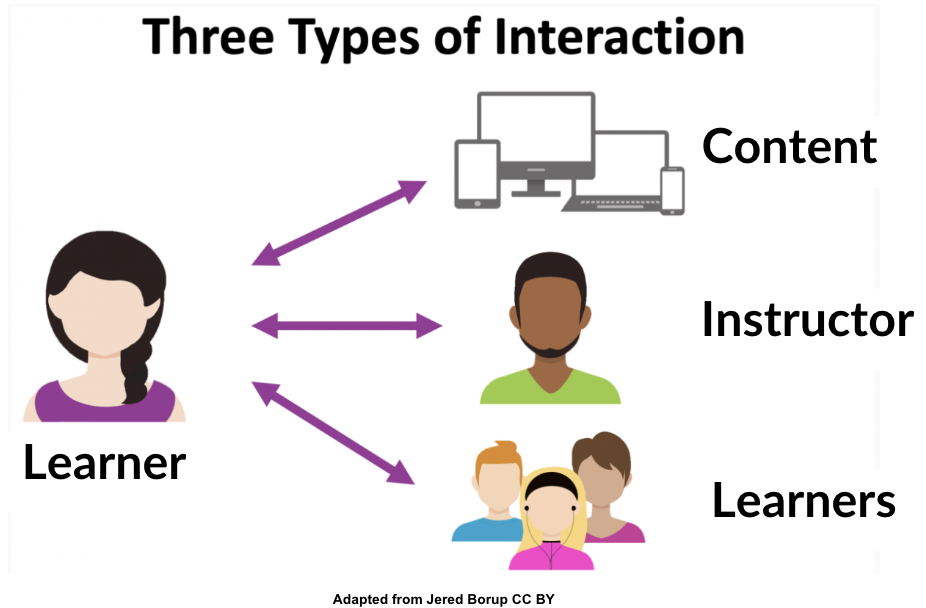
Created by Jered Borup, CC-BY-2.0
Learner-content interactions describe the interactions learners have with course content, such as reading, listening, watching, creating, practicing, and/or reflecting. Learner-instructor interactions are the ways in which the learners and the instructor interact with each other, such as the instructor giving learners feedback on an assignment or the learners asking the instructor clarifying questions. Learner-learner interactions describe the interactions learners have with each other to share their understanding and mentor each other. Table 9-4 contains some examples of the three types of interactions.
Table 9-4
Examples of Learner-Content, Learner-Instructor, and Learner-Learner Interaction
Learner-Content | Learner-Instructor | Learner-Learner |
|---|---|---|
|
|
|
Some learning activities in your course may include multiple types of interaction. For example, you may have an activity that includes both learner-instructor and learner-learner interaction, such as a class discussion. You could also have group projects, which may include learner-content, learner-instructor, and learner-learner interaction.
What might facilitation look like for different activities? See Table 9-5 for examples of activities and how instructors may use different strategies to facilitate learner-content, learner-instructor, and learner-learner interactions within each activity.
Table 9-5
Activities, Interactions, and Facilitation Strategies
Example Activity | Interactions | Possible Instructor Facilitation Strategies |
|---|---|---|
In a synchronous Zoom session, learners look at their most recent homework assignment in breakout rooms to compare solutions and the methods they used to find the answers. | Learner-learner | The instructor may assign facilitator roles to a learner in each group to help facilitate group conversations in the breakout rooms. |
Learner-instructor | The learners may invite the instructor into their breakout room when they can’t agree on an answer or method. | |
Learners are assigned to groups for in-person presentations. The learners work asynchronously in a collaborative document to prepare for the presentation. They leave comments for and respond to each other. | Learner-content | The instructor may provide a presentation template to encourage learners to create a more focused presentation. |
Learner-instructor | The instructor may ask each group to share their document with them so they can leave feedback in comments as learners work asynchronously. | |
Learner-learner | The instructor may have learners create a “team charter” to describe how they will communicate and interact with one another. | |
Learners complete a reading and then record a video response in an asynchronous discussion. In their videos, each learner will respond to a discussion prompt and share their thoughts on the reading. The instructor and 1-2 of the learners’ peers will respond to the video. | Learner-content | The instructor may post a video modeling the structure that learners’ videos should follow, such as stating which discussion prompt they are responding to, quoting directly from the reading, and/or sharing whether they agree or disagree. |
Learner-learner | The instructor may encourage learners to respond to each others’ videos. |
9.5 Computer Conferencing Moderation (Berge)
Learning Outcome: I can describe each of Berge’s four categories of facilitation—pedagogical, social, managerial, and technical.
In Berge’s (1995) framework, four categories of facilitation describe the various roles and responsibilities of an online instructor or moderator (see Figure 9-3).
Figure 9-3
Online Facilitation Framework
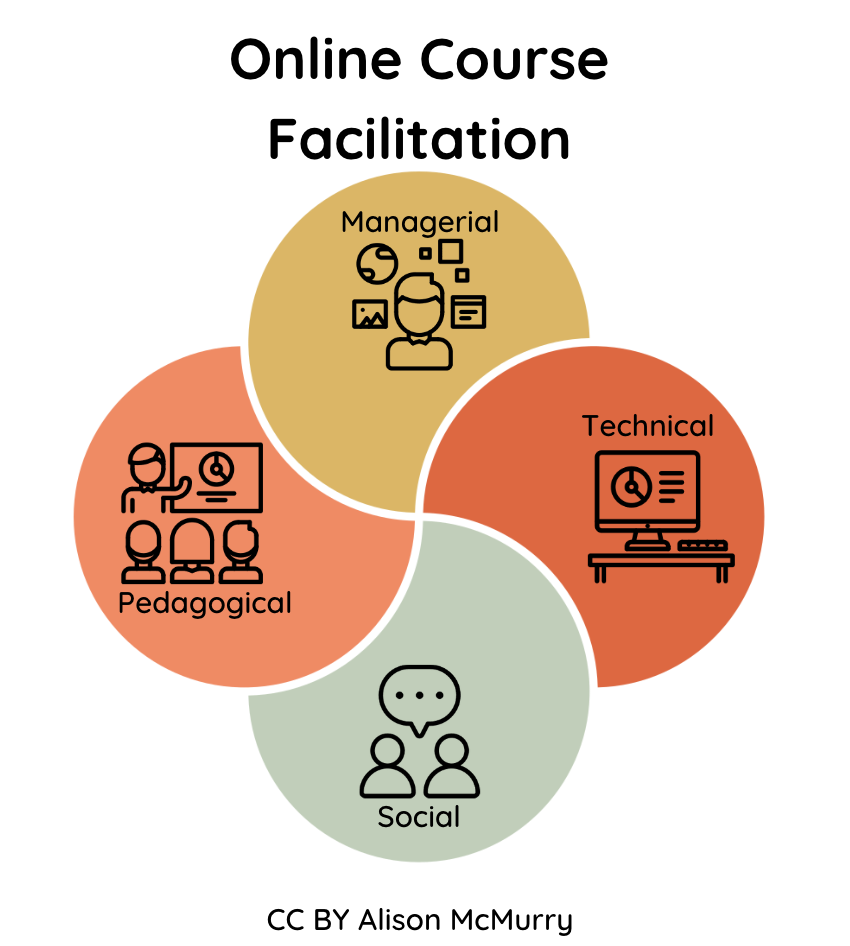
Pedagogical Facilitation: This category focuses on guiding and enhancing learners’ learning. This may include strategies such as:
Asking questions to stimulate critical thinking
Probing and elaborating on learner responses to deepen understanding
Encouraging active participation and contributions from learners
Promoting meaningful conversations among learners
Directing learners to additional resources for further exploration
Connecting and synthesizing ideas within a discussion to create coherence
Social Facilitation: This category is concerned with fostering a positive and interactive learning environment. This may include strategies such as:
Conducting icebreaker activities to build rapport and establish a sense of community
Setting a friendly and welcoming “social tone” for the course to encourage collaboration
Modeling effective discussion and interaction behaviors for learners
Assisting learners in working together on group projects
Creating dedicated spaces for learners to interact socially and build relationships
Managerial Facilitation: This category deals with the organization, procedures, and administration of the online course. This may include tasks such as:
Adjusting due dates and pacing of course activities to accommodate learner needs
Setting the agenda and desired outcomes for synchronous sessions, if applicable
Organizing learners into groups or teams for collaborative work
Defining and communicating clear course expectations and guidelines
Responding to emails or messages promptly and efficiently to address administrative needs
Technical Facilitation: This category pertains to the facilitator’s role in ensuring learners are comfortable with the technology used in the course. Berge (1995) suggested that the technological layer of the course should be facilitated in such a way that the layer is “transparent,” so learners can focus on the academic tasks. This may include responsibilities such as:
Providing video demonstrations or tutorials to help learners navigate the course learning management system (LMS) or specific tools being utilized within the course
Organizing content intuitively within the LMS to facilitate easy access and navigation
Familiarizing oneself with multimedia tools that promote learner engagement in synchronous sessions, when applicable
Guiding learners to relevant resources or materials to address technical questions and challenges
Berge’s framework acknowledges that while these facilitation categories offer a structured way to understand the roles of an online facilitator, real-world facilitation may involve some overlap between categories as tasks and functions do not always fit neatly into one category.
For example, facilitating a synchronous online discussion could involve all four types of facilitation. The facilitator is likely asking open-ended questions and probing learner responses when necessary (pedagogical facilitation). Additionally, they are setting the tone for interaction and ensuring that learners are participating in respectful ways (social facilitation). The facilitator may organize learners into smaller breakout rooms to have smaller group discussions (managerial facilitation). And lastly, the facilitator may need to help learners find and utilize tools within the conferencing platform, such as how to share their screen, join a breakout room, or raise their hand (technical facilitation).
This framework can be helpful because often instructors focus on pedagogical facilitation and don’t realize that there is a role for them to fill in terms of the other types of facilitation.
9.6 Communities of Inquiry (Garrison, Anderson, Archer)
Learning Outcome: I can discuss how cognitive, social, and teaching presence interact to create a community of inquiry.
The Communities of Inquiry (CoI) framework was developed to help understand and model the online environment elements that are necessary to facilitate effective educational experiences. While this framework was created with the online asynchronous text-based context in mind, it extends to blended and in-person contexts as well. Communities of inquiry are composed of instructors and their learners. The three main elements of this framework are cognitive presence, social presence, and teaching presence (see Figure 8-3).
Figure 9-4
Communities of Inquiry Framework
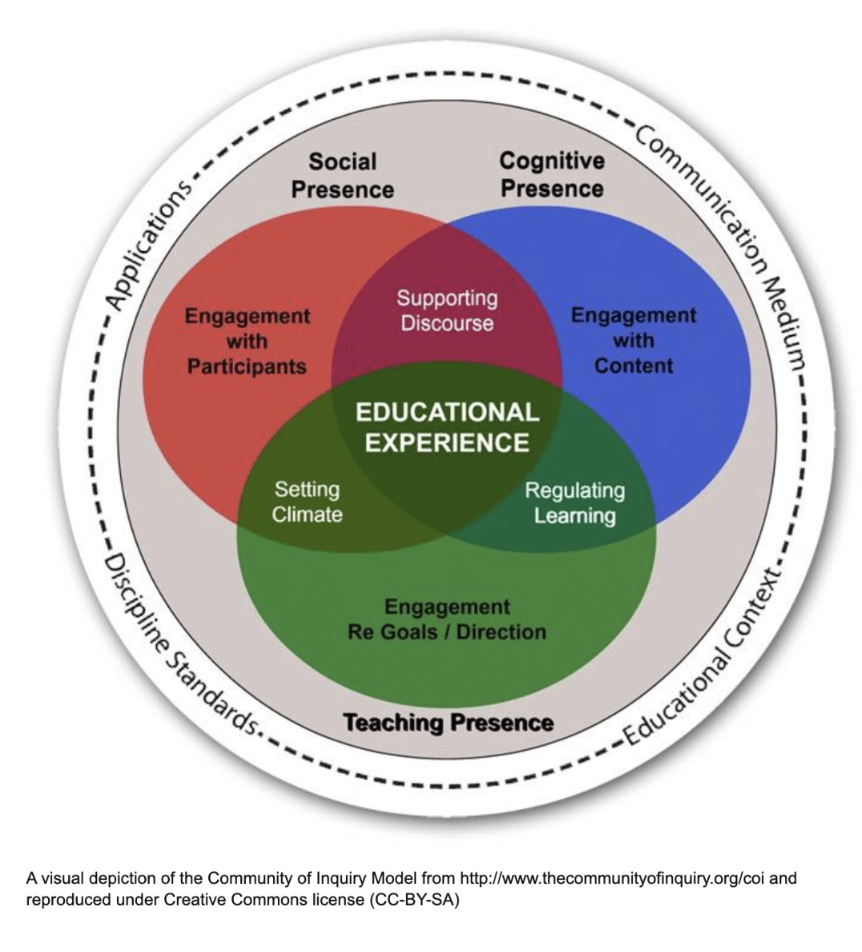
Cognitive presence describes the learners’ ability to create and exchange meaning through their communication.
Social presence describes the learners’ ability to present themselves as real people and foster relationships with others in the community. Many researchers suggest that social presence supports cognitive presence. Additionally, it is often the facilitator who sets the “social tone” of the course.
Teaching presence describes the instructor’s effort and activity with the design, facilitation, and direct instruction. Teaching presence supports both social and cognitive presence throughout the course.
As a course facilitator, there are strategies to foster each type of presence in your course. Table 9-6 describes some strategies you may use to support cognitive, social, and teaching presence.
Table 9-6
Fostering Cognitive, Social, and Teaching Presence as a Course Facilitator
Cognitive Presence | Social Presence | Teaching Presence |
|---|---|---|
|
|
|
Cognitive presence, social presence, and teaching presence interact with and support one another to create the learning environment and the learners’ educational experience. Deep and meaningful educational experiences typically necessitate all three elements.
9.7 Academic Communities of Engagement (Borup)
Learning Outcome: I can describe the affective, behavioral, and cognitive dimensions of engagement.
In the Academic Communities of Engagement (ACE) framework, learner engagement can be described across three different, but interconnected, dimensions: affective, behavioral, and cognitive (see Figure 8-4).
Affective engagement describes the learners’ emotions and attitudes involved with engaging in course learning activities. Indicators of affective engagement can include interest, enthusiasm, and enjoyment.
Behavioral engagement describes the learners’ physical behaviors involved with engaging in course learning activities. Indicators of behavioral engagement can include active participation, attendance, and completion of assignments.
Cognitive engagement describes the learners’ mental efforts involved with engaging in course learning activities. Indicators of cognitive engagement can include attention, critical thinking, and metacognition.
These dimensions of engagement are impacted by “facilitators of engagement.” These facilitators include individual learner characteristics and support from the personal and course communities. The instructor, or main facilitator, of the course can have a large influence over the course environment and the course community. When they focus beyond teaching of the content, they can also play a role in helping learners to expand relevant learner characteristics like self-regulation, social-emotional skills, and other academic competencies. While not as common in higher education, instructors can also play a role in enabling or encouraging support in the learners’ personal community.
Figure 9-5
Academic Communities of Engagement - Facilitators of Engagement
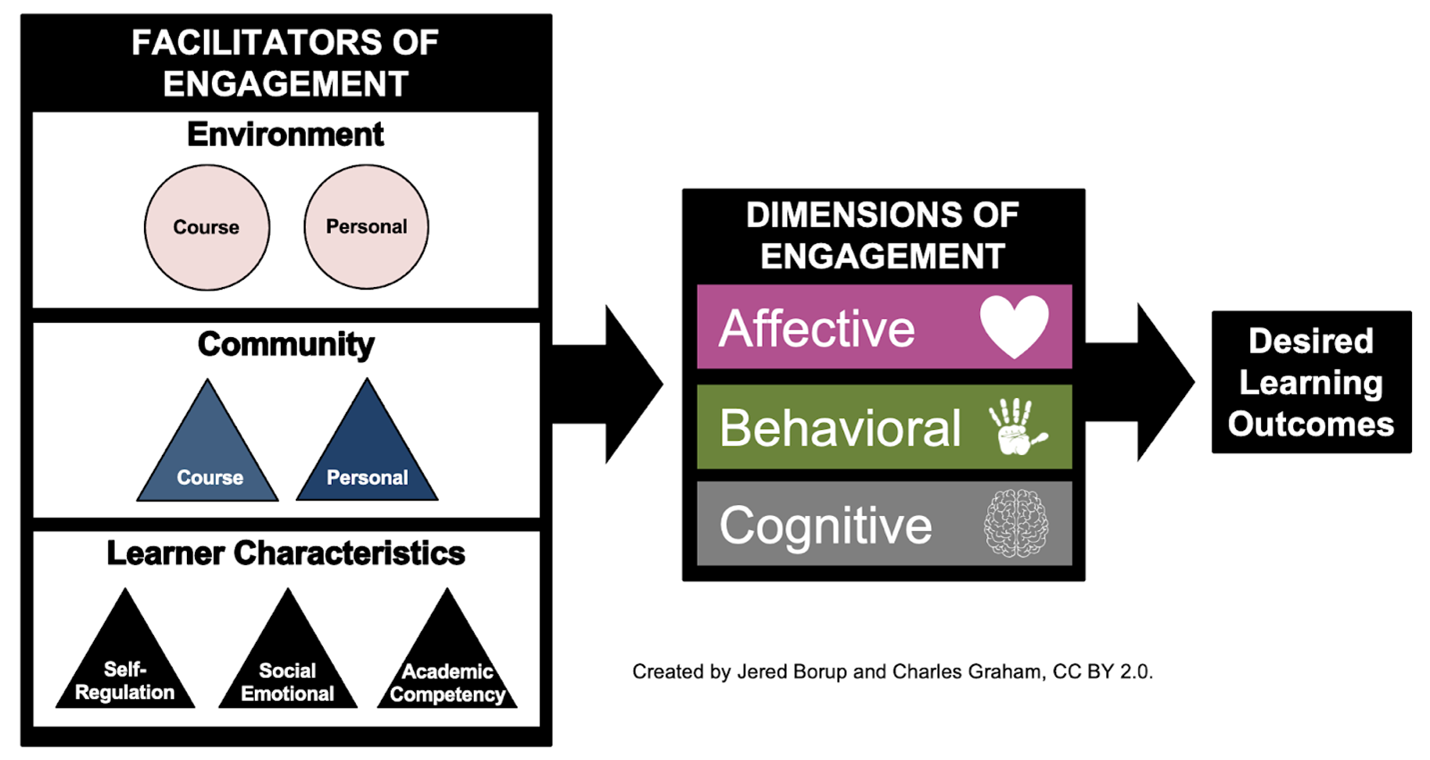
There is often an “engagement gap” between the levels of engagement learners have on their own and the engagement necessary for academic success (see Figure 9-6).
Figure 9-6
Academic Communities of Engagement Framework
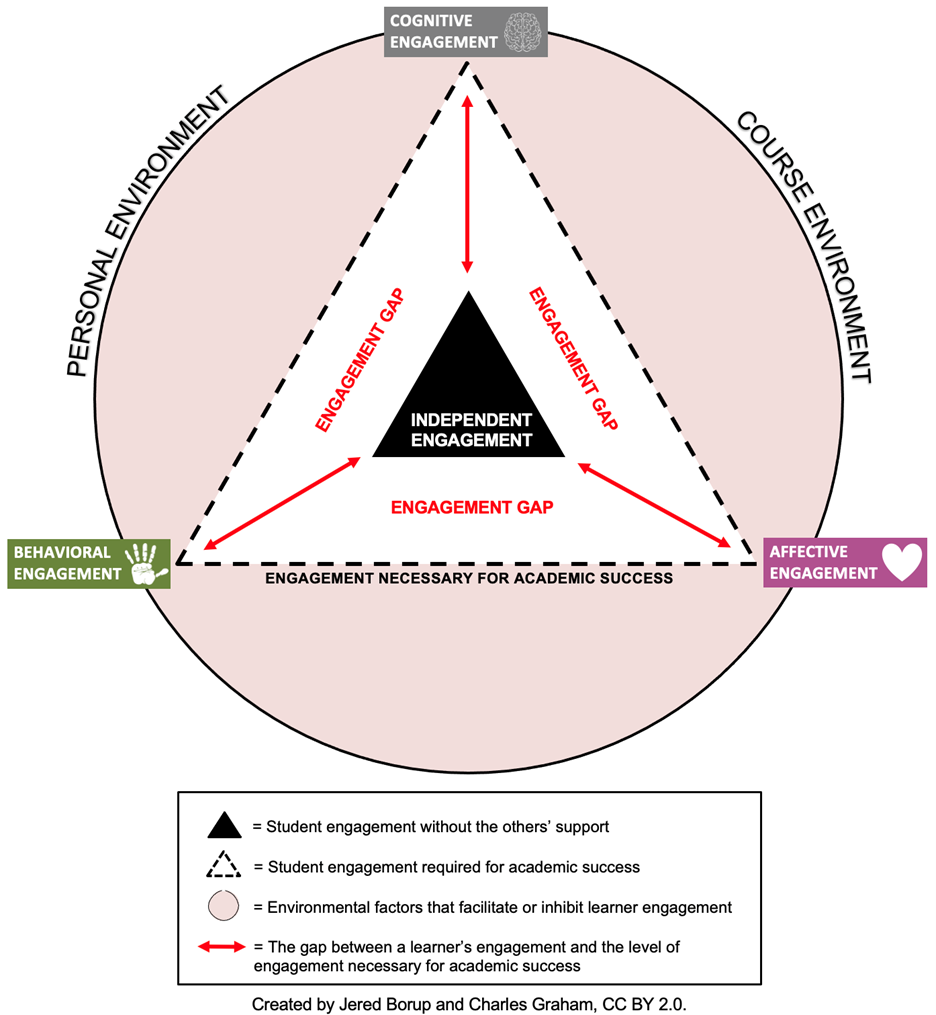
These gaps can be filled from personal community support and course community support. The course instructor or facilitator, as a large part of the course community support, can utilize a variety of strategies to support each domain of learner engagement. See Table 9-7 for a non-exhaustive list of ideas for the instructor to support learners’ affective, behavioral, and cognitive engagement.
Table 9-7
Supporting affective, behavioral, and cognitive dimensions of learner engagement
Support elements | Examples | |
|---|---|---|
Affective | Facilitating communication | Creating spaces, such as discussion forums, where learners can share their thoughts and experiences related to course content. |
Developing relationships | Initiating icebreaker activities at the beginning of the course to help learners get to know each other better. | |
Instilling excitement for learning | Sharing personal anecdotes or other examples to demonstrate how course principles apply in real-world scenarios. | |
Behavioral | Troubleshooting and orienting | Allocating time and resources at the beginning of the course to help learners navigate the course and set up any necessary tools. |
Organizing and managing | Ensuring content is structured clearly within the course and providing detailed instructions for assignments and other interactive elements. | |
Monitoring and encouraging progress | Utilizing regular formative assessments or quizzes to gauge learner understanding and progress and providing feedback to promote continuous improvement. | |
Cognitive | Instructing | Developing instructional videos or interactive presentations to deliver course content in a clear, engaging, and digestible format. |
Collaborating | Designing and incorporating collaborative group work where learners are working together to solve a problem, such as with problem-based learning. |
Adapted from Borup et al.’s Support Elements for the ABC dimensions of engagement
9.8 Why are facilitation frameworks important?
Learning Outcome: I can compare and contrast different frameworks for talking about online learning facilitation.
Understanding these frameworks will help you look at course facilitation from various perspectives and can help you as you reflect and conduct informal formative evaluations of your own facilitation. Frameworks act as lenses that allow us to see the interactions between people and content in different ways.
Let’s take the following scenario and look at its different facilitation elements using the four frameworks described in this chapter.
Scenario: For a blended class of 60 learners, Dr. Stevenson held a review session for the first midterm synchronously over Zoom. Two days before the review session, she provided the learners with a study guide, and she had the learners get together with their project groups (of 4-5 people each) to review the study guide and submit 2-3 topics or questions they would like to see addressed in the review session. They submitted their topics or questions on a discussion board, which allowed other learners to “like” topics that they also would like to see in the review. Dr. Stevenson selected the popular topics or questions and those that would specifically be helpful for them to study before the exam, organizing them into a review PowerPoint. At the beginning of the Zoom session, Dr. Stevenson briefly demonstrated to learners how to use the chat feature. Then in Zoom, learners were able to ask follow-up questions using the chat feature. See Table 9-8 for examples of framework elements found in this scenario.
Table 9-8
Frameworks and their elements found in the scenario
Framework “Lens” | Elements in Scenario |
|---|---|
Educational Interactions Framework (Anderson) | There is learner-learner interaction since learners are getting together with their groups to discuss course content and submit topics together. There is also learner-instructor interaction as the instructor responds to learner questions. The review may also facilitate learner-content interaction as learners review course content before and after the class review session. |
Computer Conferencing Models Framework (Berge) | Having learners participate by asking questions and the instructor answering those questions in the review session demonstrates pedagogical facilitation. Setting the agenda for the review session, organizing the learners into groups, and communicating expectations for posting topics/questions into the discussion board demonstrate managerial facilitation. The instructor is engaging in technical facilitation by demonstrating how to use a feature of the technology. The instructor may also serve in a social facilitation role throughout this activity, though it is not explicit in this scenario. |
Communities of Inquiry (Garrison, Anderson, Archer) | The instructor fosters cognitive presence in this scenario by grouping learners to review the study guide and having them ask questions. There is some social presence as learners interact with each other and with the instructor. And lastly, there is teaching presence as the instructor facilitates the review session and answers learners’ questions. |
Academic Communities of Engagement (Borup) | The instructor supports learners’ cognitive engagement by creating the study guide, having learners reflect on topics they may need more support in, and organizing those topics and questions into a review session. The instructor may also be supporting learners’ affective and behavioral engagement, however, it is not explicit in the description of the scenario. |
After looking at this scenario from different lenses, we can see that some framework elements were missing (or not explicitly stated), such as social and technical facilitation or supporting learners’ affective and behavioral engagement. For individual activities, it may not always be necessary to touch upon every point. For example, not every activity will warrant technical facilitation, such as when learners are already familiar with the tools. However, as you facilitate the entire course, you should be aware of these various framework elements and be intentional about when and how you are supporting your learners.
Conclusion
In this chapter, we introduced facilitation and what it means in the context of blended teaching. You learned the difference between facilitation and design and how the design can affect facilitation. And lastly, you learned why online facilitation skills are important, whether you are an instructional designer or an instructor. We also introduced four frameworks for online facilitation and explored how these frameworks can influence your facilitation strategies. These frameworks guide both instructors and instructional designers as they perform formative evaluations of facilitation strategies.
Facilitation Challenge
Looking back at how you responded on the self-evaluation, consider a course you have designed and/or will be teaching and answer the following reflection questions:
What do you feel are your strengths and weaknesses with online facilitation?
Why might online facilitation be important for learner success in this course?
What are some of the activities in the course that would most benefit from intentional facilitation?
What are some of the facilitation skills you would like to develop?
Resources
References
Berge, Z. L. (1995). Facilitating computer conferencing: Recommendations from the field. Educational technology, 35(1), 22–30. https://www.jstor.org/stable/44428247
Borup, J., Graham, C. R., West, R. E., Archambault, L., & Shin, J. K. (2023). Academic Communities of Engagement (ACE) Framework. EdTechnica: The Open Encyclopedia of Educational Technology. https://dx.doi.org/10.59668/371.12259
Garrison, D. R., Anderson, T., & Archer, W. (2000). Critical inquiry in a text-based environment: Computer conferencing in higher education model. The Internet and Higher Education, 2(2-3), 87-105.
Martin, F., Wang, C., & Sadaf, A. (2020). Facilitation matters: Instructor perception of helpfulness of facilitation strategies in online courses. Online Learning, 24(1), 28-49. https://doi.org/10.24059/olj.v24i1.1980. https://files.eric.ed.gov/fulltext/EJ1249262.pdf